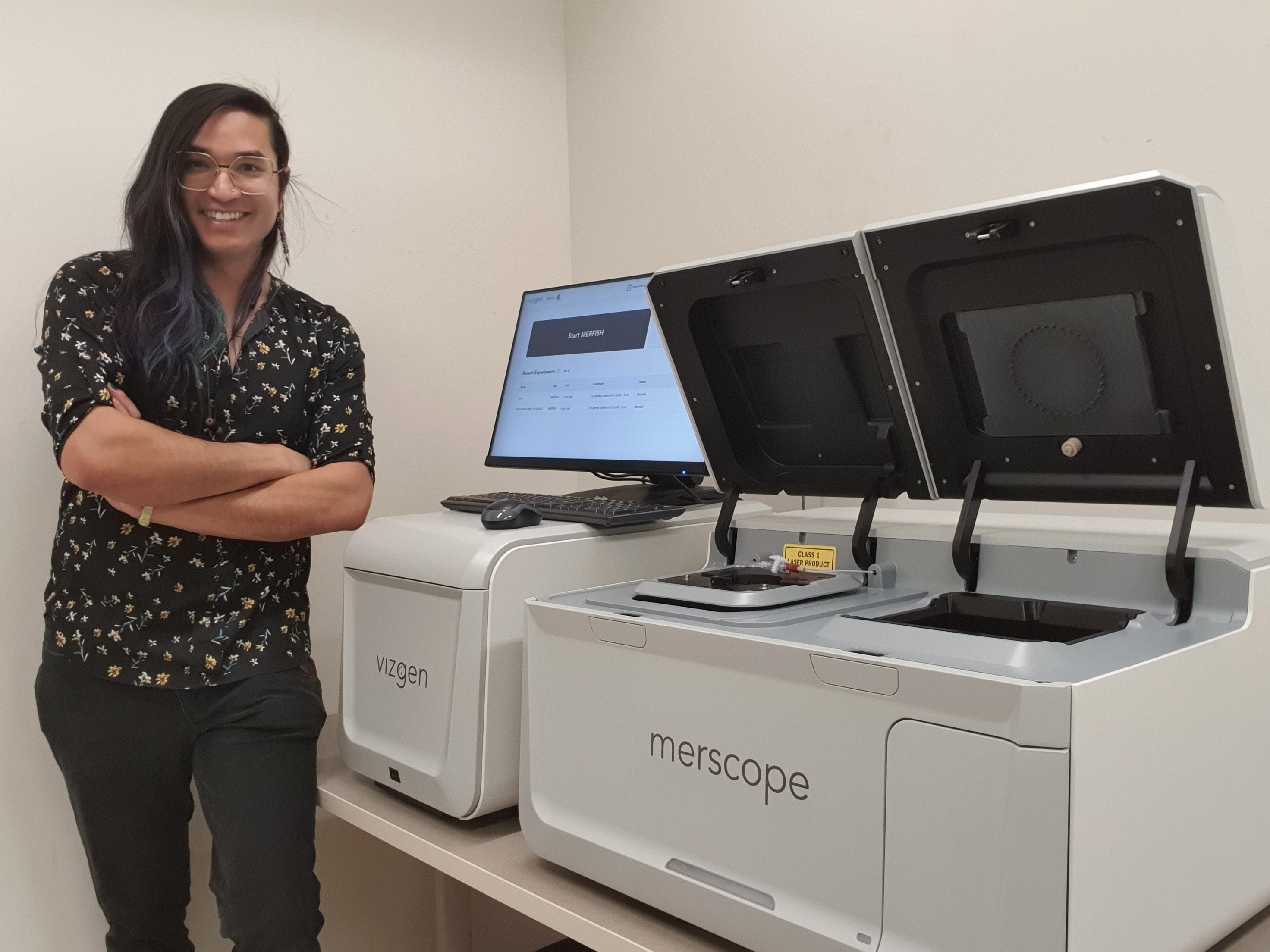U of A enters new frontier of scientific research
Shirley Wilfong-Pritchard - 19 September 2023

Mike Wong, coordinator of the Advanced Cell Exploration Core, stands beside the Vizgen Merscope.
The excitement is palpable in the University of Alberta research community. You can hear it in the voices of people like Mike Wong, coordinator of the Advanced Cell Exploration Core in the Faculty of Medicine & Dentistry and Anastassia Voronova, Canada Research Chair in Neural Stem Cell Biology and associate professor in medical genetics. With the acquisition of the Vizgen Merscope — an imaging box and processing computer that can see inside and between cells to directly map and quantify the spatial distribution of tens of thousands of RNA molecules — research at the U of A is advancing to the next level.
“It will push a lot of U of A research where we couldn’t have gone previously with the infrastructure we had,” says Wong.
What makes this technology cutting-edge
Unlike previous instruments, the Merscope uses cutting-edge technology called MERFISH (multiplex error robust fluorescence in situ hybridization) spatial transcriptomics to directly detect the expression of up to 500 genes in a single microscope image — that’s up to 500 times more powerful than traditional image-based gene expression technology that the U of A and most other institutions have been using up until now. The spatial resolution is so high it can detect low-expressing genes that earlier technology might miss and provide data on spatial characteristics of different cell types within tissues.
“This will bring light to a lot of rare cell types and how they work within the context of a tissue. I think we'll see a lot of interactions between cells that we didn't understand very well before,” says Wong.
It can analyze any type of tissue sample — human, mouse, frog, zebrafish, fruit fly or even plants. It can also access older, preserved human patient tissue samples, “giving a lot of power to clinical sample banks or previous studies that may have hit a dead end,” adds Wong.
“It’s the next level of single-cell technology,” says Voronova. ”There’s an added dimension to the big data and that’s really the power of the platform.”
First experiments
The first project to use the Merscope involves the Voronova team’s modelling of a rare neurodevelopmental disorder called KBG syndrome. Voronova explains that many patients with neurodevelopmental disorders also have heart abnormalities and vice versa. The team is studying how neural crest cells contribute to splitting the developing heart’s outflow tract into the aorta and pulmonary trunk, separating oxygenated from non-oxygenated blood, and how this process goes awry in a mouse model of KBG syndrome.
With the Merscope, they will be able to see where the cells are along this tract, how they’re behaving and interacting with other heart cells, what genes are expressing and whether there might be other genes at play that researchers were not aware of before, in the hopes that a better understanding of this process might eventually lead to meaningful impacts on patients.
Next, they want to look at the role of stem cells, not just in regenerating tissue, but also to see if they harbour any genetic mutations that may be contributing to the disease pathogenesis of neurological disorders such as multiple sclerosis.
Research possibilities and collaborative opportunities
“The possibilities are endless in terms of applied health research as well as fundamental research,” says Voronova. Spatial transcriptomics will be critical to new understandings in neuroscience, cardiovascular research, cancer research, infectious disease, developmental biology, drug, cell and gene therapy, and more.
It also opens opportunities for collaboration across research areas. Matthew Macauley and his team in the Faculty of Science, for example, are researching Alzheimer’s disease and will be sharing discoveries through ongoing collaboration with the Voronova lab, adding to their research on neurodevelopmental and neurodegenerative disorders.
“It’s housed in the Faculty of Medicine & Dentistry,” explains Wong, “but any researcher on campus will be able to become a user and gain access to the technology.”
“More exciting discoveries will be made and more collaborations, internal and external, maybe even international ones,” says Voronova.
Acquiring the Merscope — in record time
Purchasing a major piece of equipment typically takes longer than a year at a university according to Voronova. But in this case, it was secured in only eight months. The excitement around the capabilities of the Merscope started last December when Dr. Freda Miller, an internationally renowned neurobiologist, visited the U of A’s Neuroscience and Mental Health Institute to give a talk on how growth factors and stem cells build the nervous system.
The work Miller presented featured data from the Merscope platform that started the U of A’s research community buzzing. Before long, assistant dean of development Kim Falconer and her team in Advancement had embraced the goal of obtaining a Merscope, and with their support, vice-dean of research Richard Lehner was spearheading its procurement.
With $620,000 of philanthropic funding raised from the U of A community, this state-of-the-art equipment has arrived, making the U of A one of only a handful of universities in North America with this capability.
What it all means
“Being able to ask more exciting questions and perform more exciting science will inevitably attract promising candidates for faculty positions and excellent trainees. It will make us more competitive and hopefully attract new funding as well,” says Voronova. “This is going to be the next frontier, answering vital questions that are important to patients and advancing medical care — which is what we’re here to do.”
To share more about what this new technology can do, Anastassia Voronova and Mike Wong will be giving a talk about Merscope’s capabilities on Nov. 16 at 2 p.m. in the Oborowsky Degner Seminar Hall. For more information, see Research Technologies Seminar Series.